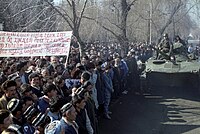TAJIKISTAN
Tajikistan,[c][d] officially the Republic of Tajikistan,[e] is a landlocked country in Central Asia. It has an area of 142,326 km2 (54,952 sq mi) and an estimated population of 9,750,065 people.[8] Dushanbe is the country’s capital and largest city. It is bordered by Afghanistan to the south, Uzbekistan to the west, Kyrgyzstan to the north, China to the east and is separated narrowly from Pakistan by Afghanistan’s Wakhan Corridor. Tajiks form the ethnic majority in the country and the historical Tajik homeland lies in present-day Tajikistan as well as parts of Afghanistan and Uzbekistan.
The territory that now constitutes Tajikistan was previously home to several ancient cultures, including the city of Sarazm[14] of the Neolithic and the Bronze Age and was later home to kingdoms ruled by people of different faiths and cultures, including the Oxus civilization, Andronovo culture, Buddhism, Nestorian Christianity, Hinduism, Zoroastrianism, Manichaeism, and Islam. The area has been ruled by numerous empires and dynasties, including the Achaemenid Empire, Sasanian Empire, Hephthalite Empire, Samanid Empire, and Mongol Empire. After being ruled by the Timurid Empire and Khanate of Bukhara, the Timurid Renaissance flourished. The region was later conquered by the Russian Empire and subsequently by the Soviet Union. Within the Soviet Union, the country’s modern borders were drawn when it was part of Uzbekistan as an autonomous republic before becoming a full-fledged Soviet republic in 1929.[15]
On 9 September 1991, Tajikistan declared itself an independent sovereign nation as the Soviet Union was disintegrating. A civil war was fought almost immediately after independence, lasting from May 1992 to June 1997. Since the end of the war, newly established political stability and foreign aid have allowed the country’s economy to grow. The country has been led by President Emomali Rahmon since 1994, who rules an authoritarian regime. There is extensive corruption and widespread violations of human rights, including torture, arbitrary imprisonment, worsening political repression, and a lack of religious freedom and other civil liberties.[16][17]
Tajikistan is a presidential republic consisting of four provinces. Most of Tajikistan’s population belongs to the Tajik ethnic group,[18] who speak the Tajik language — the first official language — making it one of the three Persian-speaking countries alongside Afghanistan and Iran. Russian is used as the official inter-ethnic language. While the state is constitutionally secular, Islam is nominally adhered to by 96% of the population. In the Gorno-Badakhshan oblast, despite its sparse population, there is large linguistic diversity where Rushani, Shughni, Ishkashimi, Wakhi and Tajik are some of the languages spoken. Mountains cover more than 90% of the country. It is a developing country with a transitional economy that is highly dependent on remittances, aluminium and cotton production. Tajikistan is a member of the United Nations, CIS, OSCE, OIC, ECO, SCO, and CSTO as well as a NATO PfP partner.
Etymology[edit]
The term “Tajik” itself ultimately derives from the Middle Persian Tāzīk, the Turkic rendition of the Arabic ethnonym Ṭayyi’, denoting a large Qahtanite Arab tribe who emigrated to Transoxiana region of Central Asia in the 7th century AD.[19] Tajikistan appeared as Tadjikistan or Tadzhikistan in English prior to 1991. This is due to a transliteration from the Russian: “Таджикистан”. In Russian, there is no single letter “j” to represent the phoneme /d͡ʒ/, and therefore дж, or dzh, is used. Tadzhikistan is the most common alternate spelling and is widely used in English literature derived from Russian sources.[20] “Tadjikistan” is the spelling in French and can occasionally be found in English language texts. The way of writing Tajikistan in the Perso-Arabic script is: تاجیکستان.
Even though the Library of Congress‘s 1997 Country Study of Tajikistan found it difficult to definitively state the origins of the word “Tajik” because the term is “embroiled in twentieth-century political disputes about whether Turkic or Iranian peoples were the original inhabitants of Central Asia,”[21] most scholars concluded that contemporary Tajiks are the descendants of the ancient Eastern Iranian inhabitants of Central Asia, in particular, the Sogdians and the Bactrians, and possibly other groups, with an admixture of Western Iranian Persians and non-Iranian peoples.[22][23] According to Richard Nelson Frye, a leading historian of Iranian and Central Asian history, the Persian emigration to Central Asia may be considered the beginning of the modern Tajik nation, and ethnic Persians, along with some elements of the Eastern Iranian Bactrians and Sogdians, as the main ancestors of the modern Tajiks.[24] In later works, Frye expands on the complexity of the historical origins of the Tajiks. In a 1996 publication, Frye explains that many “factors must be taken into account in explaining the evolution of the peoples whose remnants are the Tajiks in Central Asia” and that “the peoples of Central Asia, whether Iranian or Turkic speaking, have one culture, one religion, one set of social values and traditions with only language separating them.”[25]
Regarding Tajiks, the Encyclopædia Britannica states:
The Tajiks are the direct descendants of the Iranian peoples whose continuous presence in Central Asia and northern Afghanistan is attested from the middle of the first millennium BC. The ancestors of the Tajiks constituted the core of the ancient population of Khwārezm (Khorezm) and Bactria, which formed part of Transoxania (Sogdiana). Over the course of time, the eastern Iranian dialect that was used by the ancient Tajiks eventually gave way to Farsi, a western dialect spoken in Iran and Afghanistan.[26]
History[edit]
Early history[edit]

Cultures in the region have been dated back to at least the fourth millennium BC, including the Bronze Age Bactria–Margiana Archaeological Complex, the Andronovo cultures and the pro-urban site of Sarazm, a UNESCO World Heritage Site.[29]
The earliest recorded history of the region dates back to about 500 BC when much, if not all, of modern Tajikistan, was part of the Achaemenid Empire.[21] Some authors have also suggested that in the seventh and sixth centuries BC, parts of modern Tajikistan, including territories in the Zeravshan valley, formed part of the ancient Hindu Kambojas tribe[30][31] before it became part of the Achaemenid Empire.[32] After the region’s conquest by Alexander the Great it became part of the Greco-Bactrian Kingdom, a successor state of Alexander’s empire. Northern Tajikistan (the cities of Khujand and Panjakent) was part of Sogdia, a collection of city-states which was overrun by Scythians and Yuezhi nomadic tribes around 150 BC. The Silk Road passed through the region and following the expedition of Chinese explorer Zhang Qian during the reign of Wudi (141BC–87 BC) commercial relations between Han Empire and Sogdiana flourished.[33][34] Sogdians played a major role in facilitating trade and also worked in other capacities, as farmers, carpetweavers, glassmakers, and woodcarvers.[35]
The Kushan Empire, a collection of Yuezhi tribes, took control of the region in the first century AD and ruled until the fourth century AD during which time Buddhism, Nestorian Christianity, Zoroastrianism, and Manichaeism were all practised in the region.[36] Later the Hephthalite Empire, a collection of nomadic tribes, moved into the region and Arabs brought Islam in the early eighth century.[36] Central Asia continued in its role as a commercial crossroads, linking China, the steppes to the north, and the Islamic heartland.[citation needed]

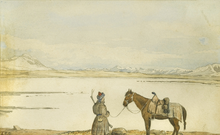
It was briefly under the control of the Tibetan Empire and the Tang dynasty from 650 to 680 CE and then under the control of the Umayyads in 710 CE.
Samanid Empire[edit]
The Samanid Empire, 819 to 999, restored Persian control of the region and enlarged the cities of Samarkand and Bukhara (both cities are today part of Uzbekistan) which became the cultural centers of Iran and the region was known as Khorasan. The empire was centered in Khorasan and Transoxiana; at its greatest extent encompassing modern-day Afghanistan, large parts of Iran, Tajikistan, Turkmenistan, Uzbekistan, Kyrgyzstan, parts of Kazakhstan, and Pakistan. Four brothers Nuh, Ahmad, Yahya, and Ilyas founded the Samanid state. Each of them ruled territory under Abbasid suzerainty. In 892, Ismail Samani (892–907) united the Samanid state under one ruler, thus effectively putting an end to the feudal system used by the Samanids. It was also under him that the Samanids became independent of Abbasid authority. The Kara-Khanid Khanate conquered Transoxania (which corresponds approximately with modern-day Uzbekistan, Tajikistan, southern Kyrgyzstan, and southwest Kazakhstan) and ruled between 999 and 1211.[37][38] Their arrival in Transoxania signalled a definitive shift from Iranian to Turkic predominance in Central Asia,[39] but gradually the Kara-khanids became assimilated into the Perso-Arab Muslim culture of the region.[40]
In the 13th century, the Mongol Empire swept through Central Asia, invaded Khwarezmian Empire and sacked the cities, looting and massacring people everywhere. Turco-Mongol conqueror Tamerlane founded the Timurid Empire in and around modern-day Tajikistan and Central Asia, becoming the first ruler of the Timurid dynasty.[41]
Bukharan rule[edit]
Modern Tajikistan fell under the rule of the Khanate of Bukhara during the 16th century and with the empire’s collapse in the 18th century it came under the rule of both the Emirate of Bukhara and Khanate of Kokand. The Emirate of Bukhara remained intact until the 20th century but during the 19th century, for the second time in world history, a European power (the Russian Empire) began to conquer parts of the region.[42]
Imperial Russia[edit]
Russian Imperialism led to the Russian Empire‘s conquest of Central Asia during the late 19th century’s Imperial Era. Between 1864 and 1885, Russia gradually took control of the entire territory of Russian Turkestan, the Tajikistan portion of which had been controlled by the Emirate of Bukhara and Khanate of Kokand. Russia was interested in gaining access to a supply of cotton and in the 1870s attempted to switch cultivation in the region from grain to cotton (a strategy later copied and expanded by the Soviets).[43] By 1885 Tajikistan’s territory was either ruled by the Russian Empire or its vassal state, the Emirate of Bukhara, nevertheless Tajiks felt little Russian influence.
During the late 19th century, the Jadidists established themselves as an Islamic social movement throughout the region. Although the Jadidists were pro-modernization and not necessarily anti-Russian, the Russians viewed the movement as a threat because the Russian Empire was predominantly Christian.[44] Russian troops were required to restore order during uprisings against the Khanate of Kokand between 1910 and 1913. Further violence occurred in July 1916 when demonstrators attacked Russian soldiers in Khujand over the threat of forced conscription during World War I. Despite Russian troops quickly bringing Khujand back under control, clashes continued throughout the year in various locations in Tajikistan. [45]
Soviet period[edit]

After the Russian Revolution of 1917 guerrillas throughout Central Asia, known as basmachi, waged a war against Bolshevik armies in an attempt to maintain independence.[46] The Bolsheviks prevailed after a four-year war, in which mosques and villages were burned down and the population heavily suppressed. Soviet authorities started a campaign of secularisation. Practising Islam, Judaism, and Christianity was discouraged and repressed, and many mosques, churches, and synagogues were closed.[47] As a consequence of the conflict and Soviet agriculture policies, Central Asia, Tajikistan included, suffered a famine that claimed many lives.[48]
In 1924, the Tajik Autonomous Soviet Socialist Republic was created as a part of Uzbekistan,[46] but in 1929 the Tajik Soviet Socialist Republic (Tajik SSR) was made a separate constituent republic;[46] however, the predominantly ethnic Tajik cities of Samarkand and Bukhara remained in the Uzbek SSR. Between 1927 and 1934, collectivisation of agriculture and a rapid expansion of cotton production took place, especially in the southern region.[49] Soviet collectivisation policy brought violence against peasants and forced resettlement occurred throughout Tajikistan. Consequently, some peasants fought collectivization and revived the Basmachi movement. Some small scale industrial development also occurred during this time along with the expansion of irrigation infrastructure.[49]

Two rounds of Stalin’s purges (1927–1934 and 1937–1938) resulted in the expulsion of nearly 10,000 people, from all levels of the Communist Party of Tajikistan.[50] Ethnic Russians were sent in to replace those expelled and subsequently Russians dominated party positions at all levels, including the top position of first secretary.[50] Between 1926 and 1959 the proportion of Russians among Tajikistan’s population grew from less than 1% to 13%.[51] Bobojon Ghafurov, First Secretary of the Communist Party of Tajikistan from 1946 to 1956, was the only Tajik politician of significance outside of the country during the Soviet Era.[52] He was followed in office by Tursun Uljabayev (1956–61), Jabbor Rasulov (1961–1982), and Rahmon Nabiyev (1982–1985, 1991–1992).
Tajiks began to be conscripted into the Soviet Army in 1939 and during World War II around 260,000 Tajik citizens fought against Germany, Finland and Japan. Between 60,000 (4%)[53] and 120,000 (8%)[54] of Tajikistan’s 1,530,000 citizens were killed during World War II.[55] Following the war and Stalin’s reign, attempts were made to further expand the agriculture and industry of Tajikistan.[52] During 1957–58 Nikita Khrushchev‘s Virgin Lands Campaign focused attention on Tajikistan, where living conditions, education and industry lagged behind the other Soviet Republics.[52] In the 1980s, Tajikistan had the lowest household saving rate in the USSR,[56] the lowest percentage of households in the two top per capita income groups,[57] and the lowest rate of university graduates per 1000 people.[58] By the late 1980s Tajik nationalists were calling for increased rights. Real disturbances did not occur within the republic until 1990. The following year, the Soviet Union collapsed, and Tajikistan declared its independence on 9 September 1991, a day which is now celebrated as the country’s Independence Day.[59]
Independence[edit]
After the beginning of the Perestroika era, declared by Mikhail Gorbachev throughout the USSR, supporters of the independence of the republics began to speak openly and freely. In Tajikistan SSR, the independence movement had been active since 1987. Supporters of independence were the Islamic Renaissance Party of Tajikistan, the Democratic Party of Tajikistan and the national democratic Rastokhez (Revival) Movement. On the eve of the collapse of the USSR, the population of Tajikistan SSR was divided into two camps. The first wanted independence for Tajikistan, the restoration of Tajik culture and language, the restoration of political and cultural relations with Iran and Afghanistan and other countries, and the second part of the population opposed independence, considering it the best option to remain part of the USSR. During the 1991 Soviet Union Referendum (the first internationally observed referendum in the country’s history) on continuing the Soviet system and the Soviet Union itself, nearly 97% of voters in Tajikistan approved of Question 1: “Do you consider it necessary to preserve the USSR as a renewed federation of equal sovereign republics, which will be fully ensured of human rights and freedoms of any nationality?”, though by dissolution in December of the same year, a significant proportion of Tajikistan’s population supported what was by then the fait accompli of independence for the union-level republics of the Soviet Union.
In February 1990, riots and strikes in Dushanbe and other cities began due to the difficult socio-economic situation, lack of housing, and youth unemployment.[46] The nationalist and democratic opposition and supporters of independence joined the strikes and began to demand the independence of the republic and democratic reforms. Islamists also began to hold strikes to demand respect for their rights and independence of the republic. The Soviet leadership introduced Internal Troops in Dushanbe to eliminate the unrest.[46]
Post-independence[edit]
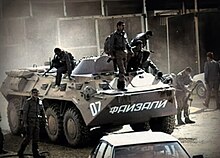
Almost immediately following independence, the nation fell into civil war among various factions; often distinguished by clan loyalties.[60] More than 500,000 residents fled during this time because of persecution, increased poverty and better economic opportunities in the West or in other former Soviet republics.[61] Emomali Rahmon came to power in 1992,[46] defeating former prime minister Abdumalik Abdullajanov in a November presidential election with 58% of the vote.[62] The elections took place shortly after the end of the war, and Tajikistan was in a state of complete devastation. The estimated dead numbered over 100,000. Around 1.2 million people were refugees inside and outside of the country.[60] In 1997, a ceasefire was reached between Rahmon and opposition parties under the guidance of Gerd D. Merrem,[46] Special Representative to the Secretary General, a result widely praised as a successful United Nations peacekeeping initiative. The ceasefire guaranteed 30% of ministerial positions would go to the opposition.[63] Elections were held in 1999, though they were criticised by opposition parties and foreign observers as unfair and Rahmon was re-elected with 98% of the vote.[46] Elections in 2006 were again won by Rahmon (with 79% of the vote) and he began his third term in office. Several opposition parties boycotted the 2006 election and the Organization for Security and Cooperation in Europe (OSCE) criticised it, although observers from the Commonwealth of Independent States claimed the elections were legal and transparent.[64][65] Rahmon’s administration came under further criticism from the OSCE in October 2010 for its censorship and repression of the media. The OSCE claimed that the Tajik Government censored Tajik and foreign websites and instituted tax inspections on independent printing houses that led to the cessation of printing activities for a number of independent newspapers.[66]
Russian border troops were stationed along the Tajik–Afghan border until summer 2005. Since the September 11, 2001 attacks, French troops have been stationed at Dushanbe Airport in support of air operations of NATO‘s International Security Assistance Force in Afghanistan. United States Army and Marine Corps personnel periodically visit Tajikistan to conduct joint training missions of up to several weeks duration. The Government of India rebuilt the Ayni Air Base, a military airport located 15 km southwest of Dushanbe, at a cost of $70 million, completing the repairs in September 2010.[67] It is now the main base of the Tajikistan air force. There have been talks with Russia concerning use of the Ayni facility,[68] and Russia continues to maintain a large base on the outskirts of Dushanbe.[69]
In 2010, there were concerns among Tajik officials that Islamic militarism in the east of the country was on the rise following the escape of 25 militants from a Tajik prison in August, an ambush that killed 28 Tajik soldiers in the Rasht Valley in September,[70] and another ambush in the valley in October that killed 30 soldiers,[71] followed by fighting outside Gharm that left 3 militants dead. To date the country’s Interior Ministry asserts that the central government maintains full control over the country’s east, and the military operation in the Rasht Valley was concluded in November 2010.[72] However, fighting erupted again in July 2012.[73] In 2015, Russia sent more troops to Tajikistan.[74]
In May 2015, Tajikistan’s national security suffered a serious setback when Colonel Gulmurod Khalimov, commander of the special-purpose police unit (OMON) of the Interior Ministry, defected to the Islamic State.[46][75]
In 2021, following the Fall of Kabul, Tajikistan allegedly got involved in the Panjshir conflict against the Taliban on the side of the National Resistance Front of Afghanistan.[76][77]
In September 2022 armed clashes, including the use of artillery, erupted along much of the border between Kyrgyzstan and Tajikistan.[78]
Politics[edit]
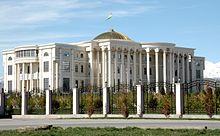
Almost immediately after independence, Tajikistan was plunged into a civil war that saw various factions fighting one another. These factions were supported by foreign countries including Afghanistan, Iran, Pakistan, Uzbekistan and Russia. Russia and Iran focused on keeping peace in the warring nation to decrease the chances of U.S. or Turkish involvement. Most notably, Russia backed the pro-government faction and deployed troops from the Commonwealth of Independent States to guard the Tajikistan-Afghan border.[79] All but 25,000 of the more than 400,000 ethnic Russians, who were mostly employed in industry, fled to Russia. By 1997, the war had ended after a peace agreement between the government and the Islamist-led opposition, a central government began to take form, with peaceful elections in 1999.[80]
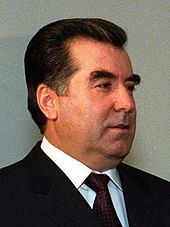
“Longtime observers of Tajikistan often characterize the country as profoundly averse to risk and skeptical of promises of reform, a political passivity they trace to the country’s ruinous civil war,” Ilan Greenberg wrote in a news article in The New York Times just before the country’s November 2006 presidential election.[81]
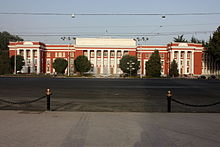
Tajikistan is officially a republic, and holds elections for the presidency and parliament, operating under a presidential system. It is, however, a dominant-party system, where the People’s Democratic Party of Tajikistan routinely has a vast majority in Parliament. Emomali Rahmon has held the office of President of Tajikistan continuously since November 1994. The Prime Minister is Kokhir Rasulzoda, the First Deputy Prime Minister is Matlubkhon Davlatov and the two Deputy Prime Ministers are Murodali Alimardon and Ruqiya Qurbanova.
The parliamentary elections of 2005 aroused many accusations from opposition parties and international observers that President Emomali Rahmon corruptly manipulates the election process and unemployment. The most recent elections, in February 2010, saw the ruling PDPT lose four seats in Parliament, yet still maintain a comfortable majority. The Organization for Security and Co-operation in Europe election observers said the 2010 polling “failed to meet many key OSCE commitments” and that “these elections failed on many basic democratic standards.”[82][83] The government insisted that only minor violations had occurred, which would not affect the will of the Tajik people.[82][83]
The Tajik government has reportedly clamped down on facial hair as part of a crackdown on Islamic influence and due to its perceived associations with Islamic extremism, which is prevalent in bordering Afghanistan.[84][85]
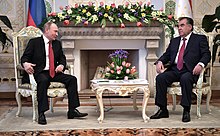
The presidential election held on 6 November 2006 was boycotted by “mainline” opposition parties, including the 23,000-member Islamic Renaissance Party. Four remaining opponents “all but endorsed the incumbent”, Rahmon.[81]
Freedom of the press is ostensibly officially guaranteed by the government, but independent press outlets remain restricted, as does a substantial amount of web content.[86] According to the Institute for War & Peace Reporting, access is blocked to local and foreign websites including avesta.tj, Tjknews.com, centrasia.org and journalists are often obstructed from reporting on controversial events. In practice, no public criticism of the regime is tolerated and all direct protest is severely suppressed and does not receive coverage in the local media.[87]
In the Economist‘s democracy index report of 2020, Tajikistan is placed 160th, just after Saudi Arabia, as an “authoritarian regime”.[88]
In July 2019, UN ambassadors of 37 countries, including Tajikistan, signed a joint letter to the UNHRC defending China’s treatment of Uyghurs in the Xinjiang region.[89]
In October 2020, Tajikistan’s authoritarian President Emomali Rahmon was re-elected for another seven-year period with 90 per cent of the votes, following a tightly controlled and largely ceremonial election.[90]
In late April 2021, a conflict over water with Kyrgyzstan escalated into one of the most serious border clashes between the two countries since independence.[91][92]
In July 2021, Tajikistan appealed to members of a Russian-led Collective Security Treaty Organization (CSTO) of ex-Soviet states for help in dealing with security challenges emerging from neighboring Afghanistan.[93] The safety concerns emerged as foreign troops such as the US and British army exited the country, causing over 1,000 Afghan civilians and servicemen to flee to neighboring Tajikistan after Taliban insurgents took control of many parts of Afghanistan.[94]

